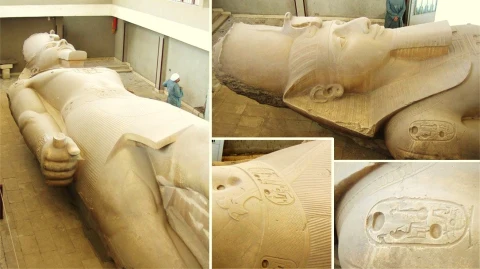
Q. What is your view on the arguments being put forth by conspiracy theorists in video’s like the Arrivals part 41, which argue the “Satanic-Pharaonic bloodline rules the World”?
A. According to the oral traditions of the Arabs, and also the Rabbinical commentators in the Midrash Genesis Rabbah, Ishmael’s mother Hagar was the Pharaoh’s daughter. This means Ishmael, the son of Abraham, and the father of the Ishmaelites, the builder of the Holy Ka’aba at Makkah, and the ancestor of the Holy Prophet Muhammad (sallallahu alaihi wa sallam), the Arabs, the Quraysh, and the Ahlul Bayt, was the grandson of the Pharaoh from his maternal side.
In the Salutations of Abraham (Darud i-Ibrahim), the descendents of Abraham are referred to as ‘Aal i-Ibrahim’, as are the descendents of the Prophet (sallallahu alaihi wa sallam) referred to as ‘Aal i-Muhammad’. The descendents of Abraham continued through his sons Ishmael and Isaac, while the descendents of the Holy Prophet (sallallahu alaihi wa sallam) continued through his daughter.
This establishes that it is correct to refer to individuals descending either from their father or mother’s side as the descendents, or ‘Aal’ of an individual. During his speech at Karbala, as recorded by Tabari and others, Imam Husayn ibn ‘Ali (alaihi salam) referred to himself as the only living grandson of a Prophet on earth. Imam Husayn’s, and the Ahlul Bayt’s descent from the Holy Prophet (sallallahu alaihi wa sallam) is through their maternal, not paternal lineage. Since Ishmael was the grandson of the Pharaoh from his maternal side, it is also correct to say that Ishmael and the Ishmaelites, amongst whom was born the Seal of Prophets, and from whose descendents will come forth the Mahdi, are also the ‘Aal’ of Pharaoh, or carriers of the Pharaonic bloodline. As such, it would be rather incorrect to refer to the entire Pharaonic bloodline as “Satanic”, Allah forbid!
Saudi Arabia finds first Pharaoh artifact dating to Ramses III
Sunday, 7 November 2010
Saudi Arabia, the birthplace of Islam, discovered a Pharaonic artifact in a northwest province of the world’s largest oil supplier, the tourism authority said.
The artifact had a hieroglyphic inscription of a signature from Ramses III, a king who ruled ancient Egypt between 1192 and about 1160 BC, the Saudi Commission for Tourism and Antiquities said in statement on its website today. The object was found near Taima oasis in Tabuk province, it said.
An ancient trade route linked the Nile Valley to the oasis, the commission said. Egyptian trading caravans carried luxury goods, like incense, gold, silver and copper, from Taima, which is one of the kingdom’s largest archeological sites, it said.
The tourism commission is promoting its Red Sea coastline and historical sites, including Madain Saleh and Souq Okaz, as destinations for visitors, according to information on its website.
Saudi tourism revenue will reach $17.6 billion in 2010 and rise to $31.4 billion in 2015, the Saudi Press Agency reported in June.
The Pharaonic relic was found about four months ago, according to the commission’s statement. Taima oasis is one of the kingdom’s largest archeological sites, the statement said.
http://www.arabianbusiness.com/saudi-arabia-finds-first-pharaoh-artifact-dating-ramses-iii-360643.html

